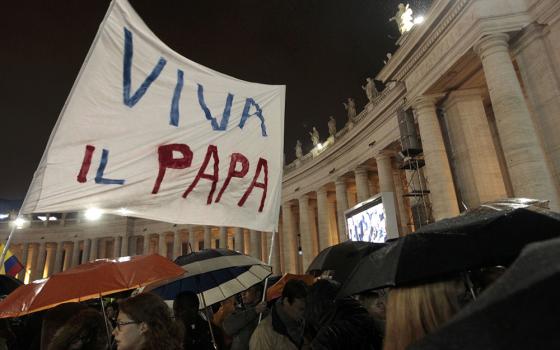“When human life is considered ‘cheap’ or easily expendable in one area, eventually nothing is held as sacred and all lives are in jeopardy.” Cardinal Joseph Bernardin spoke those words in the early 1980s as he expounded what he termed a “consistent ethic of life” and what many of us came to know as the “seamless garment” approach to life issues, the idea that the Church should not focus exclusively on abortion, but see that issue in the context of a culture that had begun to cheapen life and, thus, made abortion thinkable.
Other members of the hierarchy, most notably Cardinals Bernard Law and John O’Connor, took issue with the “seamless garment” approach. They were worried that by expanding the focus of the Church’s concern, the Church’s commitment to fighting abortion might be diluted. They wanted opposition to abortion to remain the central, preeminent focus because they understood, correctly, that in terms of sheer numbers and in terms of the horror of the act, abortion really was a graver sin against humanity than, say, capital punishment. But, however correct they were on the true magnitude of the abortion horror, they were wrong about the culture. It has been thirty years since Bernardin first invoked the seamless garment approach and met with a rebuke from his colleagues, and the pro-life movement has not made any significant advances. It is time for the leaders of the pro-life movement, and especially the leaders of the Church, to give Bernardin’s seamless garment another try.
I do not say this because I think our chances will improve politically from such a shift, although it is my hope that such an improvement might come about. I say this because I think the seamless garment approach holds open the possibility of engaging in dialogue with those who do not share currently our concern for the fate of the unborn, but who have, in other areas of life, shown a deep and abiding concern for the suffering of the weak and the marginalized. In short, those we need to convince need to hear an appeal not to what they got wrong but what they got right. When a bishop meets with local legislators, instead of chastising those who are pro-choice, might it not be more effective to say something like, “I so value your concern for these undocumented workers. How I hope someday your concern will extend to the unborn children.” Or, again, “I fully support and applaud your commitment to a living wage for all workers, but I hope someday you will also show a commitment to the right-to-life without which a living wage makes no sense.” I think Cardinal Dolan was attempting something like this in his remarks at the Al Smith Dinner, in which he firmly stated the Church’s concern for the “un’s” in our society – the undocumented, the unemployed, the unborn, the undereducated, etc.
We cannot be naïve about what we are up against. Forty years of propaganda have planted the idea firmly in the national consciousness that, at the end of the day, the decision to procure an abortion must rest with the pregnant woman. It is her body. Of course, that framing of the issue begs the question. If the unborn child is a person, why should the stronger person be able to decide the fate of the weaker? Normally, liberals of all people understand that might does not make right! But, in this instance, for a variety of complicated historical reasons, on this issue, the liberal moral compass gets it profoundly wrong. On this issue, liberals become libertarians, and resist any attempt at regulation.
The consequences are sometimes curious to watch. Last spring, if you tuned in to MSNBC, Rachel Maddow and her line-up of guests were simultaneously defending the individual mandate in the Affordable Care Act and the contraception mandate from
I have said it before and repeat it today, on the eve of the March for Life. The enemy – dare I say, the Enemy – today in our nation’s political and cultural life is libertarianism, the idea that no one has any right to tell anyone else how they should live their lives, an excessive focus on the importance of freedom at the expense of other social goods, a liberty run amok. It is found on both sides of the political aisle: Republicans talk about their income the way Democrats talk about women’s bodies: It’s mine, you can’t tell me what to do with it, hands off! Libertarianism is coarse and it is hoary but is amazingly, shockingly attractive, especially to so many of our young people. And, how could it be otherwise? In our culture, children look at TV and every five minutes they see an ad that tells them, no matter what is being sold, that here is a quick, purchasable item that can solve any given problem. Acne? Buy this ointment. Want to listen to the hippest new music? Get this app. Lonely? Sign up for this dating service. Why should we be surprised that when they face an unwanted pregnancy, they look for a “solution,” and the quicker and easier the better. And, why should we be surprised that a culture that has tolerated legalized violence against the unborn for forty years should also be a culture in which a disturbed young man thinks that the “solution” to his problems is to take a gun a shoot up a school? Bishop Cupich was spot-on in his Respect Life Sermon, in which he linked the killings in Newtown with the tragedy of abortion. A culture of gun violence and a culture of violence against the unborn stem from the same, evil root.
That evil root is not, fundamentally, moral. It is deeper, prior to moral judgment. It is the inability to see human life as a gift. And here, the co-conspirators in the culture of death include some surprising culprits. Remember these words from George Weigel on Pope Benedict’s encyclical Caritas in Veritate: “the encyclical states that defeating Third World poverty and underdevelopment requires a ‘necessary openness, in a world context, to forms of economic activity marked by quotas of gratuitousness and communion.’ This may mean something interesting; it may mean something naïve or dumb. But, on its face, it is virtually impossible to know what it means.” Weigel could not see what was plainly staring him in the face: A culture in which the fact that all is grace is not affirmed, and affirmed at the beginning, at the root and core of our understanding of the human person, such a culture is askew, such a culture that is forgetful of gratuitousness and communion as intrinsic to the human person, that is a culture that doesn’t think twice about exploiting Third World workers or killing unwanted children, and, in both instances, creating euphemisms to obscure the reality of the deed.
What Weigel and Catholic neo-cons (and some Catholic liberals too!) have never understood about either Pope Benedict or Pope John Paul II is that both men wanted the Church to get past a moralism that was already compromised by the culture, to understand that the New Commandment to love one another as He loved us is not New because it features another “add-on” to the Mosaic law, as if the Law of Moses was somehow incomplete. What is New in the New Commandment is the presence of the Lord Jesus. Pope Benedict has a beautiful passage on this in the second volume of his trilogy on Jesus of Nazareth when he discussed the washing of the feet at the Last Supper. When we celebrate the liturgy of Holy Thursday, we call the washing of the feet, the Mandatum rite. Mandatum is the opposite of libertarianism, but it is also the opposite of moralism. There is no calculation, no cost-benefit analysis, not assessment of probability. There is a command, not a moral command but something deeper, something that requires us to evaluate not our deeds but our most essential stance towards the world. Is that world something for us to manipulate as we see fit, or are we to view the world as God’s great gift? Only a culture that sees Creation as a gift is a capable of generating a culture of life. A true culture of life is horrified by both abortion and climate change. A true culture of life cares for the right-to-life and the right to a living wage. A true culture of life cares for all the “un’s” of the world. A true culture of life must make room for suffering, for humility, for the poor, for obedience, for all the things that our modern, protean culture does not celebrate.
That is why we need the seamless garment back. Not as a media strategy or a political posture. We need the seamless garment back because it belonged to Christ. Tomorrow, I hope you can march for life, but whether you can or not, pray for life. Pray for the culture. Pray that the author of life, in whom all was created, will effect the conversions of hearts we need, firstly for ourselves for conversion is never a one time thing, but secondly for our friends and family and our neighborhoods and our towns and our nation and our culture. Pope Benedict was right: Only recovering a sense of the intrinsic gratuitousness and communion of all human relations will save us from ourselves by calling our attention to Him who has already saved us.



